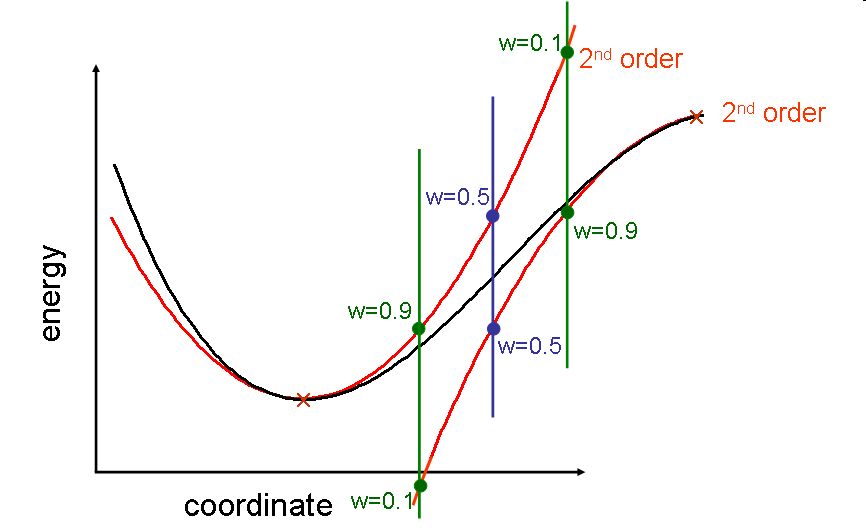» University of
Sydney » School of Chemistry
JORDAN GROUP | home | projects | Grow2.2 | publications | people | teaching | contact |
|
Project
Descriptions: Temperature
Effects on Structure |
Potential Energy Surfaces
Deborah Crittenden, Keiran Thompson Molecular potential energy surfaces (PES)
describe how the energy of a molecule changes as the positions of its
constituent atoms change. Accurate
PES are crucial to our understanding of molecular structure and
reactivity. We have developed new
interpolation techniques for constructing PES that allow the PES to be
iteratively improved until convergence in any desired molecular property
occurs. Our interpolation technique is a modified Shepard
interpolation. It uses local Taylor expansions at a set of PES data points,
where energies and derivatives have been calculated using ab initio theory. A
weighting function is used to interpolate between the Taylor expansions and
provide an analytic expression for the global, multidimensional, PES. Dynamical calculations are performed on
the interpolated PES and these are used to ‘sample’ the important regions of
configuration space for any given property of the system. These ‘sampled’
configurations are analysed and new data points are chosen. Ab initio
calculations at the new data points add to the PES data set and produce a new
interpolated PES. This process is repeated and further points are added to
the PES data set until convergence is achieved in the desired property. As
the number of PES data points increases the interpolated PES converges to the
exact PES. The PES interpolation is illustrated below:
The PES is expanded in terms of 2nd order Taylor series about each data point in a data set. Here there are 2 data points.
The simplest weighting formula is the distance to the points in the data set. That is, the energy exactly midway between the 2 data points is given as 50% of the Taylor series energy about data point 1 plus 50% of the Taylor series energy about data point 2.
The energy of a point one quarter of the way between data point 1 and data point 2 is dominated (90%) by the Taylor series energy about data point 1, wherewas the Taylor series energy about data point 2 contributes only 10% of the interpolated energy.
In this way the energy at any point can be determined, with the interpolated energy being equal to the exact energy at each data point. This scheme makes no assumption about the
nature of the PES, it does not involve fitting functional forms and the
coordinates chosen for the Taylor expansion ensure correct asymptotic
behaviour of the PES. We have used classical trajectories and
quantum wavefunctions to sample configuration space and examine both
classical and quantum properties.
These include reaction cross section, the various product
distributions for a reaction, the zero point energy and bond length and bond
angle distribution functions. We have released a computer package “Grow”
that makes our techniques freely available. The “Grow” package has recently
been combined with quantum diffusion Monte Carlo methods for determining the
ground state nuclear wavefunction of a molecule. The current implementation
of “Grow” is “Grow2.2” and it is available by clicking the “Grow2.2” tab in
the page header. Selected publications: D. L. Crittenden and M. J.
T. Jordan “Interpolated Potential Energy Surfaces: How Accurate do the Second
Derivatives Have to Be?” J. Chem. Phys., 122, 044102 (2005). D. L. Crittenden, K. C.
Thompson, M. Chebib and M. J. T. Jordan “Efficiency Considerations in the
Construction of Interpolated Potential Energy Surfaces for the Calculation of
Quantum Observables by Diffusion Monte Carlo” J. Chem. Phys. 121, 9844-9854
(2004). R. P. A. Bettens, D. H.
Zhang, M. J. T. Jordan, and M. A. Collins “Ab initio potential energy surface
for the reactions between H2O and H”, J. Chem. Phys., 112,
10162-72 (2000). K. C. Thompson, M. J. T.
Jordan and M. A. Collins, “Polyatomic molecular potential energy surfaces by
interpolation in local internal coordinates”, J. Chem. Phys., 108, 8302-8316
(1998). K. C. Thompson, M. J. T.
Jordan and M. A. Collins, “Polyatomic molecular potential energy surfaces by
interpolation in local internal coordinates”, J. Chem. Phys., 108, 8302-8316
(1998). M. J. T. Jordan and M. A.
Collins, “An Interpolated UHF Potential Energy Surface for the OH+H2
® H2O+H Reaction”, J. Chem. Phys.,104,
4600-4610 (1996). M. J. T. Jordan, K. C.
Thompson and M. A. Collins, “The Utility of Higher Order Derivatives in
Constructing Molecular Potential Energy Surfaces by Interpolation”, J. Chem.
Phys., 103, 9669, (1995). M. J. T. Jordan, K. Thompson and M. A. Collins, “Convergence of Molecular Potential Energy Surfaces by Interpolation: Application to the OH+H2 ® H2O+H Reaction”, J. Chem. Phys., 102, 5647, (1995). |



